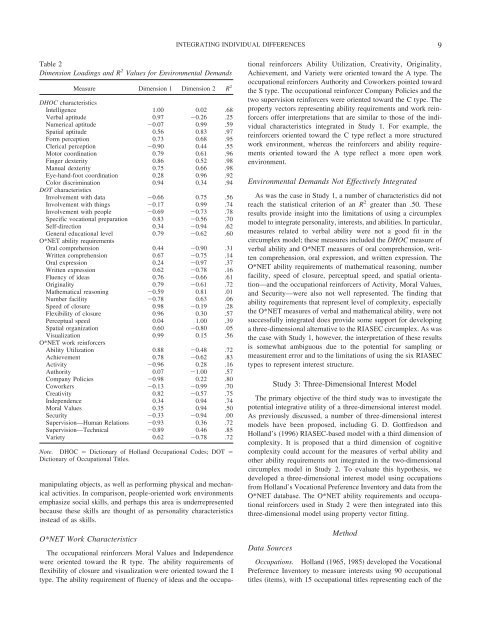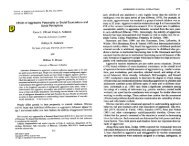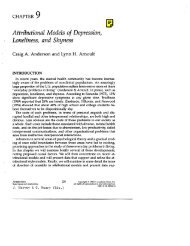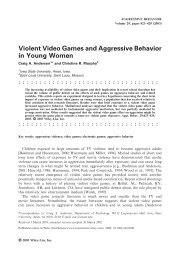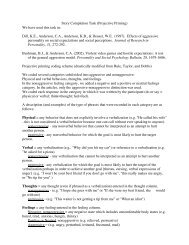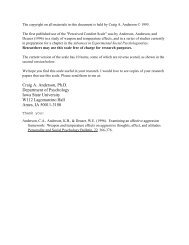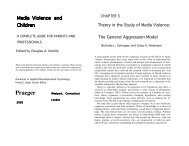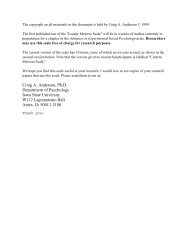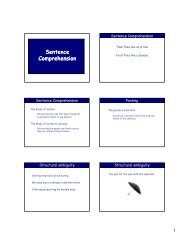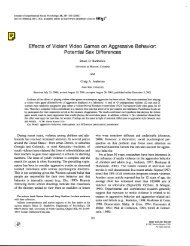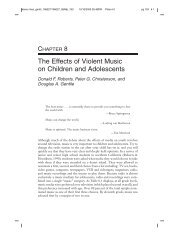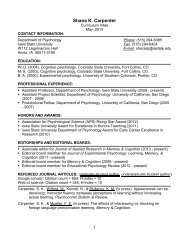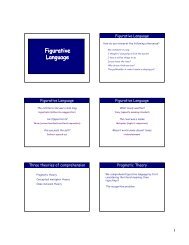Holland's RIASEC Model as an Integrative Framework for Individual ...
Holland's RIASEC Model as an Integrative Framework for Individual ...
Holland's RIASEC Model as an Integrative Framework for Individual ...
You also want an ePaper? Increase the reach of your titles
YUMPU automatically turns print PDFs into web optimized ePapers that Google loves.
INTEGRATING INDIVIDUAL DIFFERENCES<br />
9<br />
Table 2<br />
Dimension Loadings <strong>an</strong>d R 2 Values <strong>for</strong> Environmental Dem<strong>an</strong>ds<br />
Me<strong>as</strong>ure Dimension 1 Dimension 2 R 2<br />
DHOC characteristics<br />
Intelligence 1.00 0.02 .68<br />
Verbal aptitude 0.97 0.26 .25<br />
Numerical aptitude 0.07 0.99 .59<br />
Spatial aptitude 0.56 0.83 .97<br />
Form perception 0.73 0.68 .95<br />
Clerical perception 0.90 0.44 .55<br />
Motor coordination 0.79 0.61 .96<br />
Finger dexterity 0.86 0.52 .98<br />
M<strong>an</strong>ual dexterity 0.75 0.66 .98<br />
Eye-h<strong>an</strong>d-foot coordination 0.28 0.96 .92<br />
Color discrimination 0.94 0.34 .94<br />
DOT characteristics<br />
Involvement with data 0.66 0.75 .56<br />
Involvement with things 0.17 0.99 .74<br />
Involvement with people 0.69 0.73 .78<br />
Specific vocational preparation 0.83 0.56 .70<br />
Self-direction 0.34 0.94 .62<br />
General educational level 0.79 0.62 .60<br />
O*NET ability requirements<br />
Oral comprehension 0.44 0.90 .31<br />
Written comprehension 0.67 0.75 .14<br />
Oral expression 0.24 0.97 .37<br />
Written expression 0.62 0.78 .16<br />
Fluency of ide<strong>as</strong> 0.76 0.66 .61<br />
Originality 0.79 0.61 .72<br />
Mathematical re<strong>as</strong>oning 0.59 0.81 .01<br />
Number facility 0.78 0.63 .06<br />
Speed of closure 0.98 0.19 .28<br />
Flexibility of closure 0.96 0.30 .57<br />
Perceptual speed 0.04 1.00 .39<br />
Spatial org<strong>an</strong>ization 0.60 0.80 .05<br />
Visualization 0.99 0.15 .56<br />
O*NET work rein<strong>for</strong>cers<br />
Ability Utilization 0.88 0.48 .72<br />
Achievement 0.78 0.62 .83<br />
Activity 0.96 0.28 .16<br />
Authority 0.07 1.00 .57<br />
Comp<strong>an</strong>y Policies 0.98 0.22 .80<br />
Coworkers 0.13 0.99 .70<br />
Creativity 0.82 0.57 .75<br />
Independence 0.34 0.94 .74<br />
Moral Values 0.35 0.94 .50<br />
Security 0.33 0.94 .00<br />
Supervision—Hum<strong>an</strong> Relations 0.93 0.36 .72<br />
Supervision—Technical 0.89 0.46 .85<br />
Variety 0.62 0.78 .72<br />
Note. DHOC Dictionary of Holl<strong>an</strong>d Occupational Codes; DOT <br />
Dictionary of Occupational Titles.<br />
m<strong>an</strong>ipulating objects, <strong>as</strong> well <strong>as</strong> per<strong>for</strong>ming physical <strong>an</strong>d mech<strong>an</strong>ical<br />
activities. In comparison, people-oriented work environments<br />
emph<strong>as</strong>ize social skills, <strong>an</strong>d perhaps this area is underrepresented<br />
because these skills are thought of <strong>as</strong> personality characteristics<br />
instead of <strong>as</strong> skills.<br />
O*NET Work Characteristics<br />
The occupational rein<strong>for</strong>cers Moral Values <strong>an</strong>d Independence<br />
were oriented toward the R type. The ability requirements of<br />
flexibility of closure <strong>an</strong>d visualization were oriented toward the I<br />
type. The ability requirement of fluency of ide<strong>as</strong> <strong>an</strong>d the occupational<br />
rein<strong>for</strong>cers Ability Utilization, Creativity, Originality,<br />
Achievement, <strong>an</strong>d Variety were oriented toward the A type. The<br />
occupational rein<strong>for</strong>cers Authority <strong>an</strong>d Coworkers pointed toward<br />
the S type. The occupational rein<strong>for</strong>cer Comp<strong>an</strong>y Policies <strong>an</strong>d the<br />
two supervision rein<strong>for</strong>cers were oriented toward the C type. The<br />
property vectors representing ability requirements <strong>an</strong>d work rein<strong>for</strong>cers<br />
offer interpretations that are similar to those of the individual<br />
characteristics integrated in Study 1. For example, the<br />
rein<strong>for</strong>cers oriented toward the C type reflect a more structured<br />
work environment, where<strong>as</strong> the rein<strong>for</strong>cers <strong>an</strong>d ability requirements<br />
oriented toward the A type reflect a more open work<br />
environment.<br />
Environmental Dem<strong>an</strong>ds Not Effectively Integrated<br />
As w<strong>as</strong> the c<strong>as</strong>e in Study 1, a number of characteristics did not<br />
reach the statistical criterion of <strong>an</strong> R 2 greater th<strong>an</strong> .50. These<br />
results provide insight into the limitations of using a circumplex<br />
model to integrate personality, interests, <strong>an</strong>d abilities. In particular,<br />
me<strong>as</strong>ures related to verbal ability were not a good fit in the<br />
circumplex model; these me<strong>as</strong>ures included the DHOC me<strong>as</strong>ure of<br />
verbal ability <strong>an</strong>d O*NET me<strong>as</strong>ures of oral comprehension, written<br />
comprehension, oral expression, <strong>an</strong>d written expression. The<br />
O*NET ability requirements of mathematical re<strong>as</strong>oning, number<br />
facility, speed of closure, perceptual speed, <strong>an</strong>d spatial orientation—<strong>an</strong>d<br />
the occupational rein<strong>for</strong>cers of Activity, Moral Values,<br />
<strong>an</strong>d Security—were also not well represented. The finding that<br />
ability requirements that represent level of complexity, especially<br />
the O*NET me<strong>as</strong>ures of verbal <strong>an</strong>d mathematical ability, were not<br />
successfully integrated does provide some support <strong>for</strong> developing<br />
a three-dimensional alternative to the <strong>RIASEC</strong> circumplex. As w<strong>as</strong><br />
the c<strong>as</strong>e with Study 1, however, the interpretation of these results<br />
is somewhat ambiguous due to the potential <strong>for</strong> sampling or<br />
me<strong>as</strong>urement error <strong>an</strong>d to the limitations of using the six <strong>RIASEC</strong><br />
types to represent interest structure.<br />
Study 3: Three-Dimensional Interest <strong>Model</strong><br />
The primary objective of the third study w<strong>as</strong> to investigate the<br />
potential integrative utility of a three-dimensional interest model.<br />
As previously discussed, a number of three-dimensional interest<br />
models have been proposed, including G. D. Gottfredson <strong>an</strong>d<br />
Holl<strong>an</strong>d’s (1996) <strong>RIASEC</strong>-b<strong>as</strong>ed model with a third dimension of<br />
complexity. It is proposed that a third dimension of cognitive<br />
complexity could account <strong>for</strong> the me<strong>as</strong>ures of verbal ability <strong>an</strong>d<br />
other ability requirements not integrated in the two-dimensional<br />
circumplex model in Study 2. To evaluate this hypothesis, we<br />
developed a three-dimensional interest model using occupations<br />
from Holl<strong>an</strong>d’s Vocational Preference Inventory <strong>an</strong>d data from the<br />
O*NET datab<strong>as</strong>e. The O*NET ability requirements <strong>an</strong>d occupational<br />
rein<strong>for</strong>cers used in Study 2 were then integrated into this<br />
three-dimensional model using property vector fitting.<br />
Data Sources<br />
Method<br />
Occupations. Holl<strong>an</strong>d (1965, 1985) developed the Vocational<br />
Preference Inventory to me<strong>as</strong>ure interests using 90 occupational<br />
titles (items), with 15 occupational titles representing each of the


